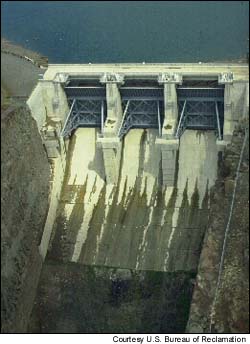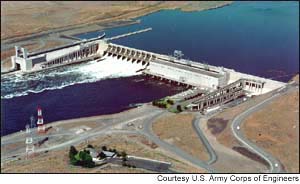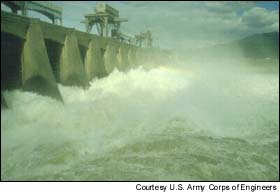forum
library
tutorial
contact

Removing Dams, Restoring Rivers
by Elizabeth GrossmanEnvironmental News Network, December 6, 1999
|
the film forum library tutorial contact |

|
Removing Dams, Restoring Riversby Elizabeth GrossmanEnvironmental News Network, December 6, 1999 |
 The damming of American
rivers has transformed
the country, and in doing
so created environmental
problems whose
resolution will greatly
influence how we live in
the next century. The
great dam building of the
past hundred years
paralleled the progress of
this American century.
Jobs were created, farms
and ranches irrigated,
and factories built that
helped win wars and
furnish the American
dream. Cities rose in the
desert, floodplains were
drained, and rivers channeled to suit civic vision.
The damming of American
rivers has transformed
the country, and in doing
so created environmental
problems whose
resolution will greatly
influence how we live in
the next century. The
great dam building of the
past hundred years
paralleled the progress of
this American century.
Jobs were created, farms
and ranches irrigated,
and factories built that
helped win wars and
furnish the American
dream. Cities rose in the
desert, floodplains were
drained, and rivers channeled to suit civic vision.
Now, barely a generation or two later, the cost of this extraordinary engineering is acutely apparent. Species of fish, once so numerous as to be legendary, are on the brink of extinction. Some are extinct. Seasons of destructive flooding have prompted reassessment of the value of wetlands, nature's reservoirs. The era of big public works projects is over.
Questioning the value of dams requires a serious readjustment in the country's notion of progress.
The efficacy of dams is being scrutinized in new comprehensive analyses of ecology, economics, energy efficiencies and local needs. Across the country, communities are identifying marginal dams, and challenging the relicensing of dams whose environmental impacts are too costly.
Questioning the value of dams requires a serious readjustment in the country's notion of progress, a process daunting to all, threatening to some. Yet dams have been removed in Maine and North Carolina, in Oregon, Vermont, Wisconsin and California, as communities rethink priorities and commit themselves to river restoration. "Dams are not like the pyramids of Egypt," said Secretary of the Interior Bruce Babbitt in July of 1998. "They ... should be judged by the health of the rivers to which they belong."
The number of dams in the country is estimated at 60,000 to 80,000.
 Dams alter and block the natural flow of rivers, interfering with fish migration, often
destroying native fish populations. They change water temperatures and degrade
water quality; both damaging to vegetation and wildlife. Dams hold back silt, debris
and other nutrients that create healthy environments for river species.
Dams alter and block the natural flow of rivers, interfering with fish migration, often
destroying native fish populations. They change water temperatures and degrade
water quality; both damaging to vegetation and wildlife. Dams hold back silt, debris
and other nutrients that create healthy environments for river species.
The number of dams in the country is estimated at 60,000 to 80,000. According to American Rivers, a non-profit organization, approximately 600,000 miles of what had been free-flowing rivers in the country, are now slackwater behind dams. The Federal Energy Regulatory Commission, who has jurisdiction over most of the nation's privately owned dams, lists well over 200 hydroelectric dams now due to be relicensed - with as many as 500 coming due in the next ten years - providing an opportunity to reconsider the future of those dams.
Dams alter and block the natural flow of rivers, interfering with fish migration, often destroying native fish populations.
 But we have become accustomed to the "benefits" of dams. In the West, heavily
subsidized power, irrigation and shipping passage for the products of the inland
Northwest form an influential piece of the region's economy. In many places
reservoirs created by dams are recreational magnets, ingrained in the custom and
character of their communities. Damming for flood control, drinking water and the
diversion of wetlands stimulated the growth of urban centers. Removing dams
affects all of this.
But we have become accustomed to the "benefits" of dams. In the West, heavily
subsidized power, irrigation and shipping passage for the products of the inland
Northwest form an influential piece of the region's economy. In many places
reservoirs created by dams are recreational magnets, ingrained in the custom and
character of their communities. Damming for flood control, drinking water and the
diversion of wetlands stimulated the growth of urban centers. Removing dams
affects all of this.
Will local communities, states and the federal government be willing to pay the costs of restoring rivers and making the changes needed to do so?
Part 2: The controversy surrounding dam removal in the Pacific Northwest to restore runs of native salmon.
learn more on topics covered in the film
see the video
read the script
learn the songs
discussion forum
